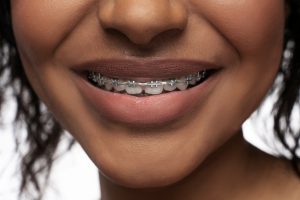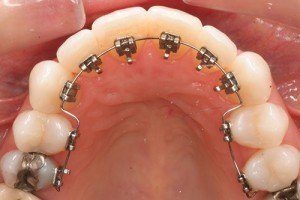Metal braces are the most commonly known and used method for straightening teeth, despite there being plenty of alternatives these days. If you’re considering metal braces for adults, you may be wondering why anyone would people still opt for them. But actually, there are plenty of good reasons why.
In this article, find out what they are, and get the answers to the following questions:
- How do braces work?
- Who is eligible for braces?
- How much do metal braces cost?
- What alternative orthodontic treatment options are there?
Metal braces are the traditional ‘train tracks’ braces that most people think of straight away whenever braces are mentioned. But, however they may look, they are still very much a popular orthodontics treatment.
That’s in part due to the fact they are affordable, effective, and have very predictable results.
What are metal braces?
They are fixed braces that consist of metal brackets that attach to the front of your teeth and are connected with a metal wire. Fixed braces need to be put on and removed by an orthodontist. That’s why they are ‘fixed’. Patients can wear them on both the top and bottom of their teeth or just on one arch.
There are a few different types of braces but traditional braces are the most well-known. They are also the most affordable when it comes to correcting moderate to severe cases of malocclusion (or tooth and bite misalignment) which is part of the reason they are so commonly used. This type of braces is even covered by federally funded health insurance, depending on the state you live in, and as long as your treatment is considered to be medically necessary.
How do metal brackets work?
Braces consist primarily of metal brackets and archwires. The metal brackets are connected by a wire that works to apply pressure to your teeth and guide them into the desired position over time. Rubber bands are used to secure the archwire to the brackets, and apply extra pressure in certain areas to better align your teeth.
These rubber bands come in different hues that you can choose, which can create the effect of having colored metal braces. But, you may just want to choose a neutral tone like white or silver.
When you first go in to get your braces put on, the dentist will use dental cement to attach the small metal brackets to the front of your teeth. Then a wire will be secured with rubber bands to connect the brackets.


You will need to go for regular appointments with your dentist or orthodontist to have your braces adjusted. This is to check your teeth are moving in the right direction and to readjust the wire so that it applies pressure correctly.
How long do braces take?
How severe your orthodontic case is will affect how long you will need to wear braces. If you have mild to moderate problems, you may only need to have them on for 6 months. However, if your case is moderate to severe you might have to wear your braces for 2 years or more.
In some cases, like with severe malocclusion, you may need to wear an orthodontic appliance before starting your braces treatment. An orthodontic appliance, like twin block braces, can add another 12 months to your treatment if your case is quite severe.
Do braces hurt?
Braces do cause discomfort and sometimes pain, but then again all orthodontic treatment does. That is because your teeth are moving and changing position which is going to hurt a little bit. There are a few different times during your braces treatment that teeth commonly hurt, including:
- When you first get your braces on
- After any adjustment appointments
- When you get your braces taken off
This is because your teeth and gums need time to adjust to any additional pressure. Other times that you may experience pain is from cuts, ulcers, or gum irritation from the metal brackets.
Who is eligible for traditional metal braces?
Generally, people get traditional braces if they have issues like crooked teeth, crowded teeth, overbite, underbite and other issues that are moderate to severe that cheaper options can’t fix.
If you have the following issues then you may be a good candidate:
- Crooked or misaligned teeth
- Gaps between teeth
- Protruding teeth
- Deep overbite
- Crowded teeth
In the following video, Dr. Greg shows how braces can be used to fixed overbites and crossbites.
If you only need mild orthodontic treatment, your dentist might suggest an alternative like clear aligners instead. But, they will take into account your lifestyle and budget when helping you come to a decision.
How much are metal braces?
If you get metal braces under private care then they will cost anywhere from $2,500 to $7,500, give or take a couple hundred on either end. Insurance may cover up to %50. But there are always annual maximums and deductibles to take into consideration.
In rare cases, if you live in a state where Medicaid has more extensive coverage, and if your braces treatment is considered to be medically necessary, as an adult, you could get your braces covered by Medicaid.
Alternatives to metal braces
Metal braces are not your only option when it comes to teeth straightening treatments. There are both fixed braces and removable braces to consider depending on your dental needs and budget.


If you are considering fixed braces then you have the following alternatives to traditional braces:
- Ceramic braces: Clear, white or tooth-colored brackets and metal or tooth-colored wires
- Lingual braces: Brackets attach to the inside of your teeth so they are only visible when your mouth is open, also known as incognito braces.
- Self-ligating braces: Don’t need elastic bands to secure the wire, and are easier for your dentist to adjust. These braces generally have a shorter treatment length than conventional braces.
While braces can improve the look and function of your smile, they can also result in mouth ulcers.
In addition to being uncomfortable, these ulcers in your mouth can spread diseases since they are open
sores. Even though most infections are minor and resolve independently, they might develop into
significant issues if the situation worsens.
You can speak with a qualified orthodontist who can advise you on the best course of action to avoid
this problem.
Dr Azariy Yusupov, DDS, Amazing Smiles Orthodontics
Removable braces or clear aligners are a great way to get straight teeth without braces and they are the least visible when you are wearing them.
They are removable clear plastic trays that are custom-made for your teeth and bite. Your treatment is monitored by a dental professional and every couple of weeks you change to new aligners.
However, not everyone is eligible for this treatment, since clear aligners are only suitable for mild to moderate cases. The good news is that invisible braces like Invisalign can treat up to 90% of orthodontic cases, but even so, when it comes to complicated cases, and especially when it comes to applying force to change the position of teeth from the roots, traditional braces have been shown to be more effective.
Ceramic braces vs metal braces
Metal braces are the most affordable fixed braces, but if you are concerned about your appearance then ceramic braces are a great alternative.
Ceramic braces are very similar, except the brackets are made from clear or tooth-colored ceramic material. They also tend to be more modern in design, with the brackets being smaller and more rounder to avoid cutting or irritating the gums, cheeks, or lips.
Clear braces vs metal braces
Clear braces are actually usually the same as ceramic braces, but they are clear and not tooth-colored. There are lots of clear braces brands to choose from. They should be as effective as metal braces, but they do come with a higher price tag.
Invisalign vs metal braces
As mentioned above, clear aligners like Invisalign are the least visible teeth straightening treatment out there. The only similarity they have with fixed braces is that they straighten and align teeth to improve your smile. The way they work to achieve those results is completely different.
While traditional braces are metal brackets, wires, and elastic bands, Invisalign is clear plastic trays molded to the shape of your teeth. This means that eating is much easier with clear aligners as well as whitening your teeth during treatment. Food can get stuck in fixed braces and they can be harder to clean, flossing is more complicated and teeth whitening with braces is just not possible.
Both treatments are monitored by dental professionals, but Invisalign tends to have a shorter treatment time scale. Generally, fixed braces are known to treat more complicated cases and clear aligners treat milder cases. However, Invisalign, the most popular aligner on the market can treat up to 90% of orthodontic cases.


Conclusion
Metal braces can treat a range of orthodontic problems, but unfortunately, they will give you a mouth full of metal. Some might say that it is worth it for a beautiful smile at the end of the treatment, and others prefer to look at other treatment options.
Fixed braces are usually made from metal brackets and are connected by wires held in place by elastic bands giving them the nickname ‘train tracks‘. But, there are alternatives to the traditional fixed brace, including lingual, self-ligating, and ceramic braces that are more modern in their technology.
Ceramic braces and lingual braces are much less visible than other fixed braces, but if how you look is a concern of yours then consider clear aligners. Clear aligners generally treat milder issues but if your case is more complicated you may still be eligible for Invisalign.
We recommend consulting your dentist or orthodontist before making a decision on your treatment.
FAQs
Are metal braces better?
Metal braces aren’t necessarily better than other options, but if you have a severe case of malocclusion, and you need braces for medical reasons, then metal braces are a good choice.
Do metal braces work faster?
Metal braces are efficient in moving teeth, but that doesn’t mean treatment time is shorter. In fact, it’s usually longer since they are meant to treat the most complicated cases.
Are metal braces good for teeth?
Metal braces are good for teeth alignment. Problems may arise when you neglect to take good care of them — meaning you don’t brush and floss properly, as plaque can collect around them.
Do metal braces damage teeth?
Metal braces won’t damage teeth. However, if you neglect to brush and floss properly, then you are at a higher risk of plaque and decay, especially behind archwires and between teeth.
NIH: A comparison of treatment effectiveness between clear aligner and fixed appliance therapies. Consulted 20th September 2022.




